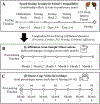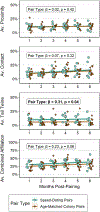Initial compatibility during a "Speed-Dating" test predicts postpairing affiliation in titi monkeys (Plecturocebus cupreus)
- PMID: 37101314
- PMCID: PMC10560403
- DOI: 10.1002/ajp.23496
Initial compatibility during a "Speed-Dating" test predicts postpairing affiliation in titi monkeys (Plecturocebus cupreus)
Abstract
Behavioral compatibility plays a critical role in shaping how potential mates interact with and evaluate each other and whether they choose to pursue a relationship. Compatibility is especially important for mate choice and relationship quality in pair-bonding species that form long-term attachments between mates. Although this process has been studied in humans and birds, relatively few studies have investigated it in non-human primates. In this study, we investigated whether pairing titi monkeys (Plecturocebus cupreus) based on initial compatibility increased postpairing affiliation between mates. Subjects were 12 unpaired adult titi monkeys (two cohorts of three males and three females). We determined each subject's initial interest in each opposite-sex potential mate in their cohort across a series of six 30-min interaction periods (i.e., "speed-dates"). To determine initial compatibility, we used the Social Relations Model to calculate relationship effects in initial interest (how much each subject uniquely preferred each potential mate beyond their own affiliative disposition and their partner's popularity). We then paired monkeys in a way that maximized net relationship effects between pairs, and measured longitudinal pair affiliation (Proximity, Contact, Tail Twining, and Combined Affiliation) for 6 months postpairing using daily scan-sample observations and monthly home-cage video recordings. Multilevel models showed that, on average, the six speed-dating pairs exhibited higher levels of Tail Twining (determined from scan-sample observations; β = 0.31) compared to a group of 13 age-matched colony pairs that were determined quasi-randomly without quantifying compatibility. The degree of initial compatibility within speed-dating pairs also predicted higher levels of Combined Affiliation (determined from video recordings) at earlier post-pairing time points, with the association peaking at 2 months postpairing (β = 0.57). These findings suggest that initial compatibility facilitates pair bonding in titi monkeys. We conclude by discussing how the speed-dating design can be used for colony management to inform pair-housing decisions.
Keywords: Social Relations Model; attachment theory; comparative animal model; initial attraction; pair bonding.
© 2023 Wiley Periodicals LLC.
Conflict of interest statement
Conflicts of Interest
The authors declare no conflicts of interest.
Figures





Similar articles
-
Relationship tenure differentially influences pair-bond behavior in male and female socially monogamous titi monkeys (Callicebus cupreus).Am J Primatol. 2020 Oct;82(10):e23181. doi: 10.1002/ajp.23181. Epub 2020 Aug 4. Am J Primatol. 2020. PMID: 32748458 Free PMC article.
-
Neural and behavioral reactions to partners and strangers in monogamous female titi monkeys (Plecturocebus cupreus).Behav Brain Res. 2023 Apr 12;443:114334. doi: 10.1016/j.bbr.2023.114334. Epub 2023 Feb 11. Behav Brain Res. 2023. PMID: 36781020 Free PMC article.
-
Dopamine D1-like receptors regulate agonistic components of pair bond maintenance behaviors in male titi monkeys (Callicebus cupreus).Psychoneuroendocrinology. 2019 Aug;106:259-267. doi: 10.1016/j.psyneuen.2019.04.012. Epub 2019 Apr 13. Psychoneuroendocrinology. 2019. PMID: 31022585 Free PMC article.
-
Titi Monkeys as a Novel Non-Human Primate Model for the Neurobiology of Pair Bonding .Yale J Biol Med. 2017 Sep 25;90(3):373-387. eCollection 2017 Sep. Yale J Biol Med. 2017. PMID: 28955178 Free PMC article. Review.
-
Pair housing of Macaques: A review of partner selection, introduction techniques, monitoring for compatibility, and methods for long-term maintenance of pairs.Am J Primatol. 2017 Jan;79(1):1-15. doi: 10.1002/ajp.22485. Epub 2015 Sep 30. Am J Primatol. 2017. PMID: 26422282 Free PMC article. Review.
Cited by
-
Improving Reproductive Success in Captive Marmosets Through Active Female Choice.Am J Primatol. 2025 Jan;87(1):e23689. doi: 10.1002/ajp.23689. Epub 2024 Nov 8. Am J Primatol. 2025. PMID: 39513469 Free PMC article.
-
Long-term cooperative relationships among vampire bats are not strongly predicted by their initial interactions.Ann N Y Acad Sci. 2024 Nov;1541(1):129-139. doi: 10.1111/nyas.15241. Epub 2024 Oct 27. Ann N Y Acad Sci. 2024. PMID: 39462880 Free PMC article.
References
-
- Ambady N, Bernieri FJ, & Richeson JA (2000). Toward a histology of social behavior: Judgmental accuracy from thin slices of the behavioral stream. In Advances in experimental social psychology (Vol. 32, pp. 201–271). Elsevier.
-
- Anderson JR, Bucher B, Chijiiwa H, Kuroshima H, Takimoto A, & Fujita K (2017). Third-party social evaluations of humans by monkeys and dogs. Neuroscience & Biobehavioral Reviews, 82, 95–109. https://doi.org/10.1016/j.neubiorev.2017.01.003 - DOI - PubMed
-
- Andersson M, & Iwasa Y (1996). Sexual selection. Trends in ecology & evolution, 11(2), 53–58. https://doi.org/10.1016/0169-5347(96)81042-1 - DOI - PubMed
-
- Arias del Razo R, Velasco Vazquez M. d. L., Turcanu P, Legrand M, Floch M, Weinstein TAR, Goetze LR, Freeman SM, Baxter A, Witczak LR, Sahagún E, Berger T, Jacob S, Lawrence RH, Rothwell ES, Savidge LE, Solomon M, Mendoza SP, & Bales KL (2022). Long term effects of chronic intranasal oxytocin on adult pair bonding behavior and brain glucose uptake in titi monkeys (Plecturocebus cupreus). Hormones and Behavior, 140, 105126. https://doi.org/10.1016/j.yhbeh.2022.105126 - DOI - PMC - PubMed
-
- Baker KC, Bloomsmith MA, Oettinger B, Neu K, Griffis C, Schoof V, & Maloney M (2012). Benefits of pair housing are consistent across a diverse population of rhesus macaques. Applied Animal Behaviour Science, 137(3), 148–156. https://doi.org/10.1016/j.applanim.2011.09.010 - DOI - PMC - PubMed
Publication types
MeSH terms
Grants and funding
LinkOut - more resources
Full Text Sources

